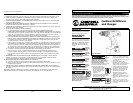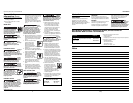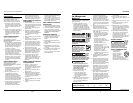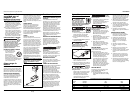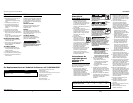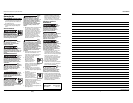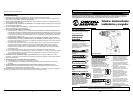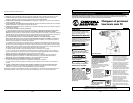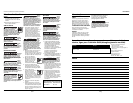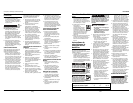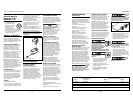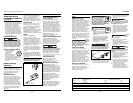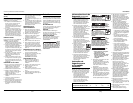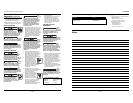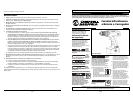
28 Sp
Instrucciones de
seguridad para el
cargador y las
baterías (Continuación)
15.El cargador de la batería no está
concebido para otros usos que no
sean cargar la batería recargable.
Cualquier otro uso puede dar lugar
a riesgo de incendio, choque
eléctrico o electrocución.
16.El cargador se ventila a través de las
ranuras de las partes superior e
inferior de la caja. No bloquee las
ranuras de ventilación ni coloque la
caja en un lugar donde las ranuras
de ventilación puedan quedar
bloqueadas. Esto puede dar lugar a
calor intenso y riesgo de incendio.
CÓMO DESECHAR LA BATERÍA
No
intente
desarmar la batería ni quitar ningún
componente que sobresalga de las
terminales de la batería. Puede
provocar un incendio o lesiones. Antes
de desechar la batería, proteja las
terminales expuestas con cinta
aisladora gruesa para evitar que se
produzcan cortocircuitos.
BATERÍA DE NÍQUEL-CADMIO
• Si está equipada con
una batería de níquel-
cadmio, la batería
debe reciclarse o
desecharse de manera
que no dañe el medio
ambiente. Verifique con el
Departamento de Obras Públicas de
su condado la información sobre
cómo reciclar baterías.
Cómo cargar la
batería
CÓMO RETIRAR LA BATERÍA
Antes de cargar, retire la batería de la
herramienta presionando el botón de
liberación de la batería y tirando de la
batería hacia afuera de la herramienta.
INSTRUCCIONES GENERALES
Con el uso normal, a medida que la
batería se va descargando, observará
una importante disminución en el
rendimiento de la herramienta.
Cuando la herramienta no es capaz de
realizar la tarea, es hora de recargar la
batería. El recargar la batería antes de
llegar a esta condición reducirá la vida
útil total de la misma. Descargar la
batería más allá de este punto puede
dañarla.
NOTA: la temperatura de la batería
aumentará durante el uso y enseguida
después de usarla. Es posible que las
baterías no acepten una carga total si
se cargan inmediatamente después de
usarlas. No cargue la batería si se
siente caliente al tacto. Espere a que se
enfríe.
CARGA INICIAL
Antes de usar la herramienta por
primera vez, cargue la batería por
completo. Dependiendo de la
temperatura ambiente y del voltaje de
línea, la batería debería cargarse por
completo en 2 (dos) a 4 (cuatro) horas
con el cargador rápido DG029300AV. La
carga estará completa cuando se
encienda la luz verde.
CARGA
CARGADOR Y BATERÍA
Conecte las clavijas de conducción de
corriente en el cable de corriente a un
tomacorriente de pared de 120V CA,
60Hz. El cargador viene con un LED; se
encenderá una luz roja mientras esté
cargando. Una vez que la batería esté
completamente cargada, una luz verde
indicará que la carga está completa.
Con el uso normal, la batería estará
totalmente cargada después de
aproximadamente 1 (una) a 2 (dos)
horas. Retire la batería del soporte y
desenchufe del tomacorriente de pared.
La batería de carga DG029200AV se
cargará únicamente con el cargador
DG029300AV. Desconecte el cargador
de la fuente de energía mientras no lo
esté usando.
IMPORTANTE: LA BATERÍA NO DEBERÁ
DEJARSE EN EL CARGADOR DURANTE
MÁS DE 48 (CUARENTA Y OCHO)
HORAS.
Funcionamiento
INTERRUPTOR DE GATILLO DE
VELOCIDAD VARIABLE (algunos
modelos)
Si su taladro/destornillador está
equipado con un interruptor de gatillo
de velocidad variable, la presión que
usted aplique al gatillo controlará la
velocidad de la herramienta. Aplique
más presión para aumentar la
velocidad y libere presión para
disminuir la velocidad. Este control de
velocidad preciso le permite perforar
sin hacer orificios con el punzón y usar
el taladro/destornillador como un
destornillador a motor. Hay brocas
disponibles para atornillar tornillos así
como también colocar pernos y
tuercas.
BOTÓN DE AVANCE/RETROCESO
Este taladro/destornillador está
equipado con una palanca de
avance/retroceso que se usa para
cambiar la rotación de la broca. No
intente cambiar la rotación a menos
que la broca esté completamente
detenida.
El mover
el botón
de avance/retroceso mientras la broca
está girando puede dañar la
herramienta.
Para la rotación de avance, presione
con firmeza en la palanca con la
inscripción FWD. Para la rotación de
retroceso, presione con firmeza en la
palanca con la inscripción REV.
SEGURO DEL GATILLO
Para activar el seguro del gatillo,
mueva la palanca de avance/retroceso
para que quede en el centro del
mango.
CAMBIO DE VELOCIDADES
El taladro/destornillador DG141900CD
está equipado con dos rangos
separados de velocidades, alta y baja.
La posición baja proporciona torsión
alta y velocidades más bajas de
perforación para trabajo pesado o
para atornillar tornillos. La posición
alta proporciona velocidades más altas
para trabajos de perforación más
livianos. Para cambiar de velocidad,
coloque el interruptor en la posición
alta o baja. Presione apenas el gatillo
si el cambio de velocidades no se
engancha por completo.
Nota: Si el taladro/destornillador está
funcionando, pero la broca no gira,
verifique para asegurarse de que el
interruptor de cambio de velocidad
esté oprimido completamente en la
configuración deseada.
Manual de Instrucciones y Lista de Piezas
Carga Rápida y Batería
Operation (Cont’d.)
GENERAL DRILLING
The front end of the
Drill/Driver may be made
“live” if the tool drills into
live wiring in the wall. TO
PREVENT ACCIDENTAL ELECTRICAL
SHOCK, HOLD DRILL/DRIVER ONLY BY
THE SOFT GRIP HANDLE.
Safety glasses and ear
protection must be worn
during operation.
1. Set torque adjusting collar for
drilling operation and set speed
selector to appropriate speed.
2. Be sure drill bit is securely gripped
in chuck.
3. Set FORWARD/REVERSE BUTTON for
clockwise rotation.
Make
sure
work is held securely in a vice or
clamped in place prior to starting
drilling operation. Loose work may
spin and cause bodily injury.
4. Locate exact center for hole to be
drilled and using a center punch,
make a small dent in work.
5. Place tip of drill bit in dent made by
center punch, hold drill square with
work, and start the motor.
Applying
too much
pressure may cause the bit to overheat
or break, resulting in bodily injury or
damaged drill bits.
Apply steady, even pressure to keep
drill bit cutting. Too little pressure
will keep the bit from cutting.
Eventually, the excessive friction
created by sliding over the surface
will dull the cutting edges.
Always
be alert
and brace yourself against the twisting
action of the drill.
6. If drill stalls or becomes jammed in
the hole, release trigger
immediately, remove drill bit from
work and determine cause of
stalling or jamming.
Do not
squeeze
trigger on and off in an attempt to free
a stalled or jammed drill. This will
damage the motor.
The direction of rotation may be
reversed to help free a jammed bit.
Be sure direction of rotation is
RESET before attempting to
continue drilling.
7. Reduce the pressure on the drill just
before the bit cuts through the
work to avoid splintering wood or
stalling in metal.
8. When bit has completely
penetrated work and is spinning
freely, withdraw it from the work
while the motor is still running,
then turn off drill.
DRILLING WOOD
In addition to the instructions listed
under GENERAL DRlLLlNG, the
following also apply:
1. When using a twist drill in wood,
frequently withdraw it from the hole
to clear away chips which build up in
the flutes. This helps prevent
overheating and burning work.
2. If a backing block is used to keep
back of work from splintering,
clamp it securely in place. If a
backing block is not used with
spade bits or hole saws, ease up
pressure as soon as bit point breaks
through work, and complete the
hole from the opposite side.
DRILLING METAL
In addition to the instructions listed
under GENERAL DRlLLlNG, the
following also apply:
1. Use only good quality sharp high
speed steel twist bits when drilling
metal.
2. Start drilling with slow speed and
gradually increase speed as drill cuts.
The harder the material, the slower
the speed required. The softer the
material, the faster the speed.
3. When drilling a large hole, it is easier
to first drill a smaller hole and then
enlarge it to the required size.
4. The use of a lubricant, such as oil,
on the drill point helps keep the bit
cool, increases drilling action and
prolongs drill bit life.
5. If possible, punch the drilling
position first to prevent drill bit run
away.
DRIVING WOOD SCREWS
1. Drill pilot and shank clearance
holes. See chart titled “Suggested
Hole Sizes for Wood Screws.”
2. Install proper screwdriver bit.
3. Set torque adjusting collar for
desired torque and set speed
selector to “1,” the low-speed
setting.
4. Set drill for correct rotation.
5. Start screw straight in hole with
fingers.
6. Place bit on screw, start drill and
exert pressure to drive screw.
7. As soon as screw has seated, release
trigger, and lift screwdriver from
screw.
8. A lubricant, such as soap or wax,
may be used on screw threads for
ease of driving. This is particularly
important in hard wood.
9. Combination pilot drill, shank drill
and countersink bits are available
from local supply houses for drilling
holes in one easy operation.
Suggested Hole Sizes For Wood Screws
Shank Drill Pilot Drill Diameter
Screw Clearance Soft Hard
Size Diameter Wood Wood
#6 5/32 (.156) 1/16 (.062) 5/64 (.078)
#8 11/64 (.172) 5/64 (.078) 3/32 (.093)
#10 13/64 (.203) 3/32 (.093) 7/64 (.109)
#12 15/64 (.234) 7/64 (.109) 1/8 (.125)
DG141900CD
www.chpower.com
5



